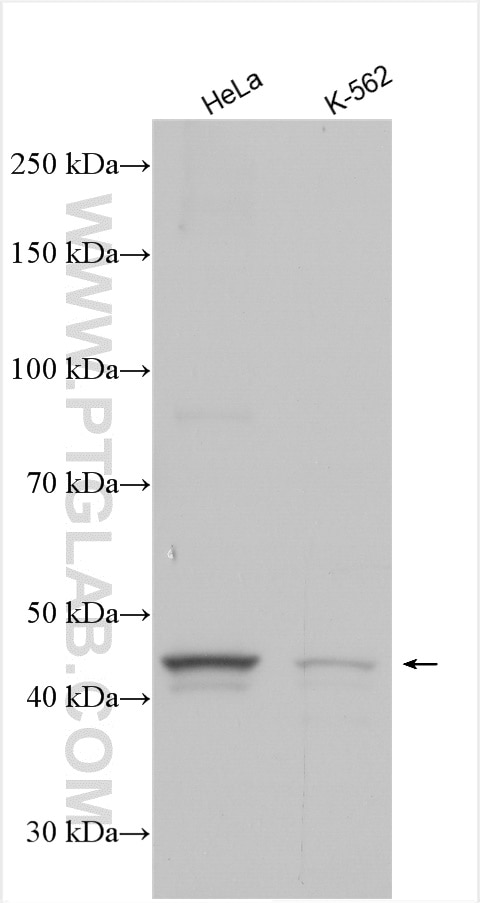Anticorps Polyclonal de lapin anti-GPR151
GPR151 Polyclonal Antibody for WB, ELISA
Hôte / Isotype
Lapin / IgG
Réactivité testée
Humain
Applications
WB, ELISA
Conjugaison
Non conjugué
N° de cat : 30104-1-AP
Synonymes
Galerie de données de validation
Applications testées
| Résultats positifs en WB | cellules HeLa, cellules K-562 |
Dilution recommandée
| Application | Dilution |
|---|---|
| Western Blot (WB) | WB : 1:500-1:1000 |
| It is recommended that this reagent should be titrated in each testing system to obtain optimal results. | |
| Sample-dependent, check data in validation data gallery | |
Informations sur le produit
30104-1-AP cible GPR151 dans les applications de WB, ELISA et montre une réactivité avec des échantillons Humain
| Réactivité | Humain |
| Hôte / Isotype | Lapin / IgG |
| Clonalité | Polyclonal |
| Type | Anticorps |
| Immunogène | GPR151 Protéine recombinante Ag32442 |
| Nom complet | G protein-coupled receptor 151 |
| Masse moléculaire calculée | 47kd |
| Poids moléculaire observé | 46 kDa |
| Numéro d’acquisition GenBank | NM_194251 |
| Symbole du gène | GPR151 |
| Identification du gène (NCBI) | 134391 |
| Conjugaison | Non conjugué |
| Forme | Liquide |
| Méthode de purification | Purification par affinité contre l'antigène |
| Tampon de stockage | PBS with 0.02% sodium azide and 50% glycerol |
| Conditions de stockage | Stocker à -20°C. Stable pendant un an après l'expédition. L'aliquotage n'est pas nécessaire pour le stockage à -20oC Les 20ul contiennent 0,1% de BSA. |
Informations générales
G protein-coupled receptors (GPCRs) are a superfamily of cell-surface receptors which are important for intracellular signal transduction. GPR151 (G protein-coupled receptor 151) is highly enriched in the the medial and lateral habenula and is expressed at presynaptic membranes and synaptic vesicles (PMID: 32098843). GPR151 has been reported to play an important role in modulating neuropathic pain and controling nicotine addiction vulnerability (PMID: 32098843,34244727,30373770).
Protocole
| Product Specific Protocols | |
|---|---|
| WB protocol for GPR151 antibody 30104-1-AP | Download protocol |
| Standard Protocols | |
|---|---|
| Click here to view our Standard Protocols |


